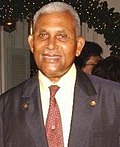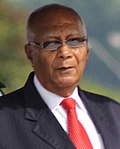 |
|---|
This is a list of the heads of state of Trinidad and Tobago, from the independence of Trinidad and Tobago in 1962 to the present day.
Contents
From 1962 to 1976, the head of state under the Trinidad and Tobago Independence Act 1962 was the queen of Trinidad and Tobago, Elizabeth II, who was also the monarch of the other Commonwealth realms. The Queen was viceregally represented in Trinidad and Tobago by a governor-general. Trinidad and Tobago became a republic under the Constitution of 1976 and the monarch and governor-general were replaced by a ceremonial president.









